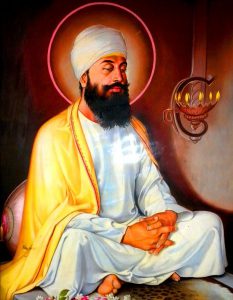What happened?
Guru Tegh Bahadur, the ninth Guru of the Sikh religion was beheaded on the orders of Mughal Emperor Aurangzeb on 24 November 1675 in Delhi.
Guru Tegh Bahadur Biography
Guru Tegh Bahadur was born on 1 April 1621 in Amritsar and was named Tyaga Mal at birth.
His parents were Guru Hargobind and Mata Nanaki. Guru Hargobind was the sixth Sikh Guru.
As a child, Guru Tegh Bahadur was trained in martial arts, swordsmanship and horse riding. But despite being an able fighter alongside his father in different battles, he seemed to choose a path of renunciation and meditation.
He was married to Gujari in 1633. In 1656, they moved to the village of Bakala where Tegh Bahadur would spend a lot of time in contemplation and prayers.
Tegh Bahadur’s father had not chosen him as his successor as he felt that the Sikhs at that time needed a worldly leader and his son had chosen the path of renunciation. So, Guru Hargobind elected his grandson Guru Har Rai as his successor. After Har Rai’s death at the age of 31, his son Har Kishan became the seventh Guru at the age of five. Har Kishan, however, died of a disease at the age of 7 in 1664.
After that, there was confusion as to who would become the ninth Guru. Before his death, Guru Har Kishan had pronounced that the next Guru would be found in Bakala. This was followed by many ‘pretenders’ in Bakala each claiming to be the Guru.
As per Sikh tradition, Guru Tegh Bahadur was confirmed as the real Guru through a story involving a wealthy merchant Baba Makhan Shah Labana. Labana had once offered 500 gold coins to the Sikh Guru if his life was spared. He arrived in Bakala and offered 2 gold coins to each person claiming to be the ninth Guru. All of them accepted the 2 gold coins. When Tegh Bahadur was given the 2 gold coins, he said that it fell short of what was originally prayed and promised by Labana. This convinced Labana that he was indeed the Sikh Guru and he made it public to the world.
Accordingly, in August 1664, Guru Tegh Bahadur was anointed the ninth Guru of the Sikhs.
Guru Tegh Bahadur travelled far and wide visiting many places in northern India and also Assam and Dhaka, preaching the word of Guru Nanak.
He started community water wells and langars (community kitchen for the poor and hungry).
In 1668 in Assam, he was able to preach a treaty between the King of Ahom and Raja Ram Singh of Amber who was sent there by Aurangzeb.
In 1672, he visited Kashmir where he saw the persecution of non-Muslims.
Guru Tegh Bahadur composed many hymns that were added to the Guru Granth Sahib. He wrote the Saloks, 116 shabads and 15 ragas.
He founded the city of Anandpur Sahib in Punjab in 1665.
The Guru attracted huge numbers of devotees and followers. This is said to have distressed the Mughal Emperor. It is also said that the Guru’s promise of protection to the persecuted Kashmiri Pandits also led to his being summoned to Delhi by the Emperor. While the Sikh faith was gathering strength, Aurangzeb was following a policy of religious discrimination and persecution in many places. Tegh Bahadur was brought before the Emperor when he reached Delhi.
On 24 November 1675, the Guru was publicly beheaded on the orders of Aurangzeb for refusing to accept the authority of Mughal Emperor, at Chandni Chowk in Delhi. Gurdwara Sis Ganj Sahib was built in 1783 at the place where he was beheaded.
His young son Gobind, who was only nine when his father was killed, became the tenth and the last Sikh Guru. The effect of his father’s cruel murder must have been profound on him. Guru Gobind Singh went on to become the founder of the Khalsa and challenged the authority of the Mughals.

